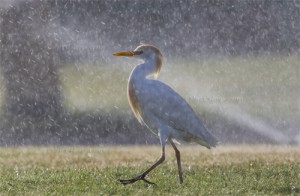 This species of heron is renown to spend a lot of time close to livestock like grazing cattle and grab insects and worms that their hooves disturb. But on these pictures you can see, that the Cattle Egret feels attracted to other human environment as well. Weather the egret seeks the spray of the lawn sprinkler in search of insects and worms or weather it just like a cool shower running along its feathers is not clear. But anyway, a great impression which couldn´t be missed. Without haste the bird marched under the spray of the water from one side of the green rondell to the other. The images were shot in March 2012 in the park called Green Mubazzarah near Al Ain/ UAE at the foot of the Hajar Mountains. Green Mubazzarah is a picnic area with streams, grass and chalets at the northern base of Jebel Hafeet before the road starts to climb upwards towards the summit of Jebel Hafeet. Lawn sprinklers are abundant and in full action in the mornings to preserve the green in a extremely desert environment. The green in the desert does not only attract Cattle Egret and other birds present year-round in that area like Chukar, Grey Francolin, Laughing Dove und Eurasian Collared-Dove but also many migrating birds like e.g. Blue Rock-Thrush, Rufous-tailed Rock-Thrush, Eurasian Hoopoe, Pied, Northern, Isabelline and Desert Wheatear, Wagtails and Water Pipits.
This species of heron is renown to spend a lot of time close to livestock like grazing cattle and grab insects and worms that their hooves disturb. But on these pictures you can see, that the Cattle Egret feels attracted to other human environment as well. Weather the egret seeks the spray of the lawn sprinkler in search of insects and worms or weather it just like a cool shower running along its feathers is not clear. But anyway, a great impression which couldn´t be missed. Without haste the bird marched under the spray of the water from one side of the green rondell to the other. The images were shot in March 2012 in the park called Green Mubazzarah near Al Ain/ UAE at the foot of the Hajar Mountains. Green Mubazzarah is a picnic area with streams, grass and chalets at the northern base of Jebel Hafeet before the road starts to climb upwards towards the summit of Jebel Hafeet. Lawn sprinklers are abundant and in full action in the mornings to preserve the green in a extremely desert environment. The green in the desert does not only attract Cattle Egret and other birds present year-round in that area like Chukar, Grey Francolin, Laughing Dove und Eurasian Collared-Dove but also many migrating birds like e.g. Blue Rock-Thrush, Rufous-tailed Rock-Thrush, Eurasian Hoopoe, Pied, Northern, Isabelline and Desert Wheatear, Wagtails and Water Pipits.
The birding strategy is to go early in the morning. The official opening times is: 9am to 9pm, but cleaning service start right after dawn so you might be able to slip in the park with the service staff. Best is to avoid Fridays and Saturdays as well as public holidays when the park is crammed full of people although staying overnight in tents is forbidden in the meantime. This area is best birded from dawn for 2-4 hours.
The Cattle Egret is a species of the heron family found in the tropics, subtropics and warm temperate zones all over the world. It is the only member of the monotypic genus Bubulcus, although some authorities regard its two subspecies as full species, the Western Cattle Egret (Bubulcus ibis) and the Eastern Cattle Egret (Bubulcus coromandus). Originally native to parts of Asia, Africa and Europe, it has undergone a rapid expansion in its distribution and successfully colonised much of the rest of the world. It has even seen in Northern Europe and the UK in increasing numbers. The Cattle Egret is breeding now in Belgium and the Netherlands and also in Germany Bubulcus ibis has been seen recently in increasing numbers as e.g. the Ochsenmoor, (near the Lake Duemmer), Niedersachsen, on the 2nd of May 2012 or at Donaueschingen, Baden-Württemberg, on 10th of April 2012 or in Niederwalgern near Marburg, Hessen, on the same day.